Published 16 February 2020 ● Last Updated on 15 July 2020
This week, our guest author is Chloe Chotrani, a farm guide and media manager at Bollywood Adventures. She shares tips on how we can get started on growing our very own herb garden – all we need is soil, suitable herbs and taking creative control!
Bollywood Adventures hosts educational and fun activities allowing city dwellers to get hands on experience in farms, thereby connecting better with nature. They’re headquartered at Bollywood Veggies, a 10-acre vegetable farm which is run on sustainability principles and is open to the public for farm-to-table meals and back-to-nature activities.
With the rising rate of chronic diseases caused by poor eating habits, holistic health should become a priority and should be practiced daily at home. Nature offers us medicine. With a bit of nurturing, maintenance, and a new hobby– we can enjoy the subtle yet long term benefits of growing our own healing herb garden.
In Singapore, people often say “I don’t have green fingers, I kill plants!”. To change that negative mindset, here is a healthy and fun challenge for you: Initiate a garden in your home – even if it is with just one herb! We recommend familiar, easy-to-grow local herbs that thrive in our weather and do not have too many pest issues.
Growing a garden is a practice of giving life, as these herbs nourish you and your loved ones in return. Here is a guide to five medicinal and culinary herbs for your first herb garden at home, and some tips to make your garden thrive. Do read till the end for tips to choosing healthy soil and even rooting instructions for first-timers among you!
Herb 1: Indian Borage
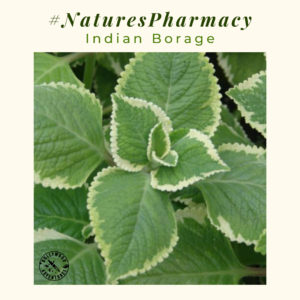
Indian borage or Asian Oregano is a healing herb best known for treating cough or a sore throat, a common ailment in contemporary conditions. It is high in vitamins A and C, and has omega-6 content. This herb can be boiled in water and drank as a tea with lemon and honey if desired. It has a strong and acquired taste.
Indian borage has anti-inflammatory properties and can also be used to topically treat minor bites and stings. If negative symptoms develop, stop using it and consult a doctor, of course!
It can also be cooked with food as a substitute for oregano to flavour meat and vegetable dishes. Its dried leaves can be added into soups and stews for a punch!
Indian borage best grows by stem cuttings. This plant should have partial sunlight for at least four hours. If the plant gets too much sun, it turns yellow and starts to curl. If it gets the right amount of sun, it should be a vibrant jade-green colour. It is a hardy and low-maintenance plant. If you were to start with only one herb, we recommend you start with Indian borage!
Herb 2: Thai Basil
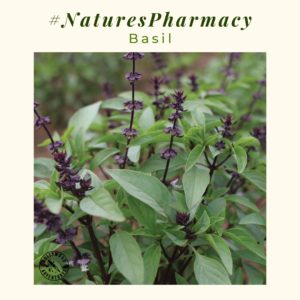
A common herb that’s familiar, fairly easy to grow, and a great addition to your food – curries, salads, fried rice, noodles, or pastas! Thai basil has an aromatic, fresh, and slightly stronger taste as compared to the Italian sweet basil. It is used to relieve digestive issues such as constipation and gas. Its aroma and taste is believed to reduce stress, with long-term benefits including reducing blood pressure and memory loss.
Thai basil is easily propagated by the stem cutting method or by seeds procured at a local nursery or plant shop. Since it is a low-maintenance plant, it can flourish indoors as well as outdoors as long as you make sure it receives enough light – at least six hours of natural sunlight. The soil should be well-drained and moist – not over-watered and soggy, as with all herbs.
When the flowers start to grow, you can cut them off, so that the leaves can grow instead of the flowers. You want more of the leaves so that you can harvest it for cooking or making teas. Propagate and harvest your basil frequently, so that it continues to encourage new growth.
Herb 3: Lemongrass
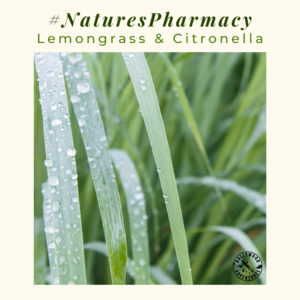
One of the easiest plants to grow at home is lemongrass.
Lemongrass has antioxidant properties which may help prevent the dysfunction of cells inside your coronary arteries, along with anti-inflammatory properties which plays a role in preventing heart disease and stroke which have high mortality rates. Components of lemongrass help to fight cancer by boosting your immune system, lowering blood pressure, and cholesterol. For these healing effects to take place, one must be consistent and consume these herbs regularly – make a habit out of it.
You can buy lemongrass from the market or supermarket that still have the bulbs intact. Place the bulbs in a glass vase with a few inches of water and allow the roots to grow. Change the water frequently. Once you see that there are new roots –take it out of water and plant it in soil. It can grow into a tall plant and enjoys plenty of sunlight! It will thrive outside if you have an outdoor space for it. Similar to most herbs, remember to harvest to encourage further growth.
Herb 4: Mint
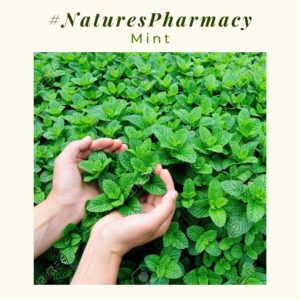
Mint or mentha grows all around the world in a large number of varieties! A versatile culinary herb with a wide variety, from a sharp and intense flavour of spearmint, or a more delicate peppermint, apple mint which is good with iced tea, or chocolate mint for desserts! Mint is good to soothe mild chest and throat pain, and its nutrients include vitamin A, a fat-soluble vitamin critical for eye health and night vision, it potentially improves irritable bowel syndrome and it’s cooling aroma is good for brain function – especially as an essential oil.
Mint thrives in both cold and warm climates, either full sun or partial shade. It is known to be an invasive plant because it spreads vigorously – we recommend having it in a container. It makes a great garnish for sauces, salads, or cocktails.
Herb 5: Ginger
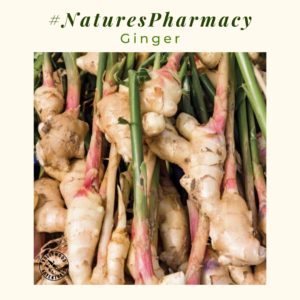
Lastly, a grounding root vegetable, still commonly considered as an herb. Gingers are important because they protect you from bacterial infections. They expand your blood vessels to allow oxygen to rush to the internal area that needs soothing. The heat that one feels when drinking a strong ginger infused tea – is a detoxification process, it raises the electricity of the body. They have a variety of bio-actives – one of which is gingerol, which counteracts nausea and other stomach ailments. Depending on which ginger you decide to buy, plant, or harvest – they have various qualities.
To grow ginger, you can start with a fresh root ginger, the rhizome of the plant which you can buy at the supermarket or at Geylang Serai for a wider variety. You need to choose a piece which grows buds because the shoots will develop from these buds. If you do go to the wet market, you can ask at the stall directly which pieces they recommend for planting.
The growing tips at the end of each ‘finger’ of the rhizome will sprout, there will be slim leaves from the end. Plant these rhizomes in a pot, keeping in mind that the plant can grow up to a meter and a half, so it will need enough space and a big enough pot to allow more extensive root growth to accommodate that. If healthy, by eight to ten months, the ginger plant will be fully grown – ginger teaches us patience too. A little bit of ginger a day keeps the doctor away!
Be Resourceful
Since these herbs we are recommending are familiar and common, we suggest finding stem cuttings from your neighbours or local community gardens. Stem cuttings are when you cut the growing tip of a stem to propagate and re-pot it into a new plant. You can place stem cuttings directly into the soil. Here is a step-by-step guide which you may apply to other herbs as well:
Step 1: Cut a length of the central stem ( 5 to 8 inches) with nodes.
Step 2: Remove the leaves from the bottom, about 2 to 3 nodes to allow rooting.
Step 3: Make a hole in the soil and gently place the stem cutting into it. Pack the soil tightly around it so that it is securely planted.
Step 4: Water the newly propagated plant daily. The soil should be moist, do not overwater and drown the plant.
Alternatively, stem cuttings produce roots when placed in water. You can apply steps 1 and 2, and for step 3 you can put it in water instead of directly into soil. It is essential that you regularly change the water and do not submerge the leaves in the water as it will rot. Once the roots start to grow, you can transfer it into a pot with soil.
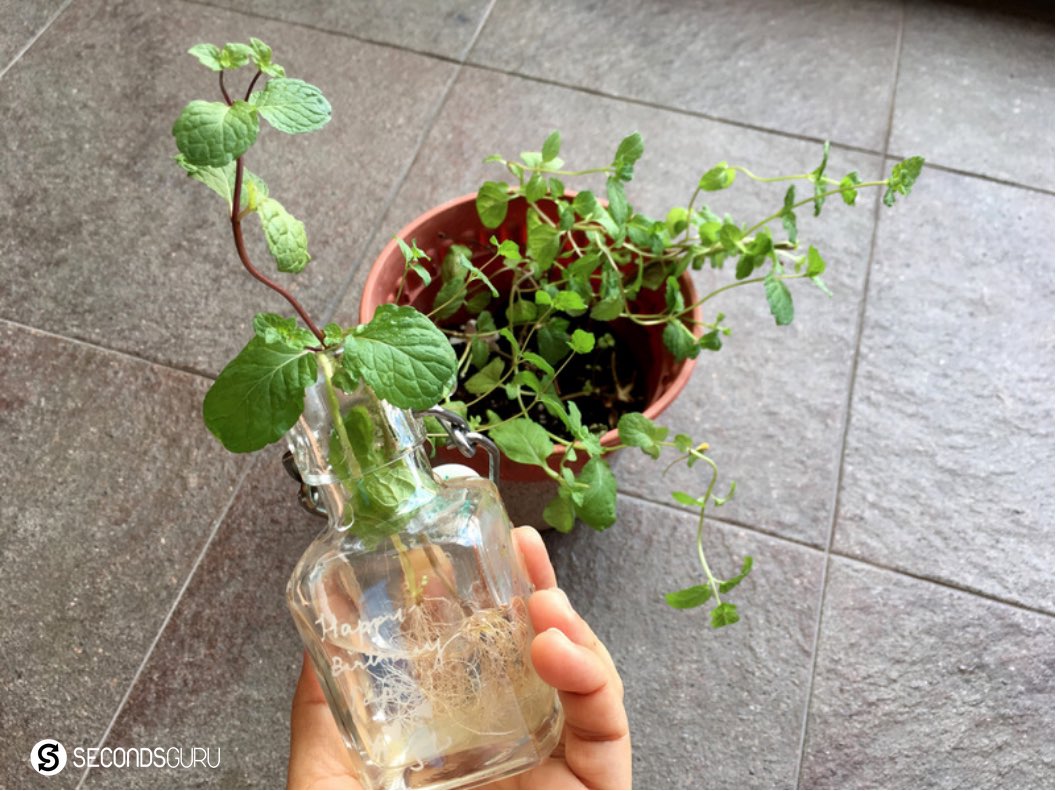
If your neighbour or friends have these herbs – you can ask them for some cuttings. If not, you can go to a local plant nursery to buy a plant. As this plant grows, you can continue the stem cutting process to propagate more plants and share this gardening skill with neighbours and friends!
Growing Medium: Healthy Soil
What is soil actually made of? Soil is composed of minerals, organic matter, compost, water, air. Minerals or weathered rocks have been broken down by forces of wind, rain, and other biological processes and can consist of sand, clay or coco-peat. Organic matter is remains of soil organisms and plant life while compost is a balance of carbon (dry leaves, hay, sawdust, paper) and nitrogen (organic raw kitchen scraps such as orange peels, eggshells, etc.), water, and oxygen. The magic is in the microbes – worms, insects, and microbes that thrive when the soil is healthy.
If you are looking for reliable sources to buy healthy soil and organic fertilizers, I recommend Green Spade and O Green Living.
Visit Bollywood Veggies in Kranji Countryside
We welcome you to explore our Bollywood Adventures programmes and public events to get a more hands-on education on local Southeast Asia herbs. We offer farm-tours at a 10-acre planet-friendly vegetable farm and activities such as pot-a-plant where you can plant and bring home beginner-friendly plants such as pandan or kang kong. While you are there, you may enjoy a hearty farm-to-table meal at Poison Ivy’s Bistro after your hard work. We have a small shop where you can buy some farm products and plants.
To plan your visit to Bollywood Veggies and other farms in Kranji Countryside, you can visit our website or FB Page to know more.
Take Creative Control
Give your home a new life! Remember that you can take creative control – your garden can be a small countertop garden for your kitchen or you can be more ambitious and explore a medium-scale herb garden by the balcony, or have a few potted plants near by the window making sure they receive the right amount of sunlight! Explore what suits your lifestyle and home best. Treat this as a practice of active listening – plants sometimes tell you what they need, you just need to be aware by heightening your listening and observation skills with this hands-on and family friendly activity!
Related Articles:
Family Weekends | Walk, swing or bug-hunt your way to explore nature at Bollywood Veggies!
Cutting to life: How my brown thumb learned to grow herbs and other plants!

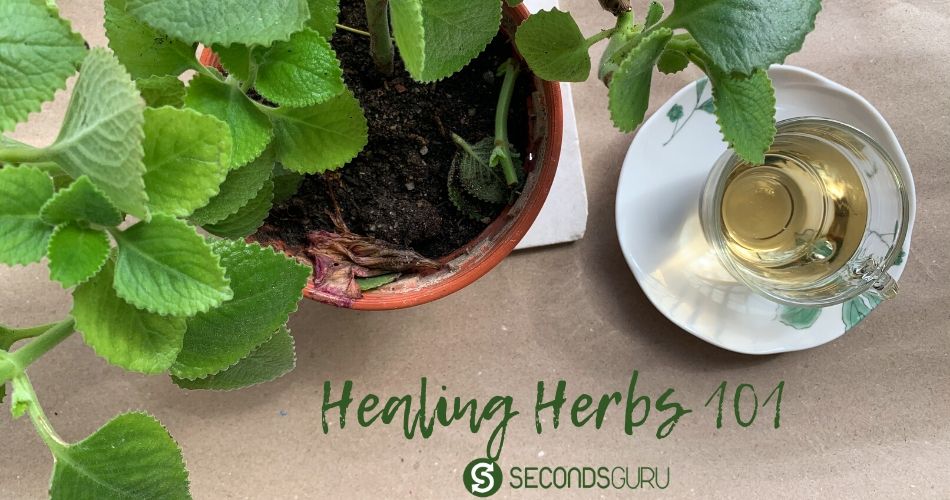


0 Comments